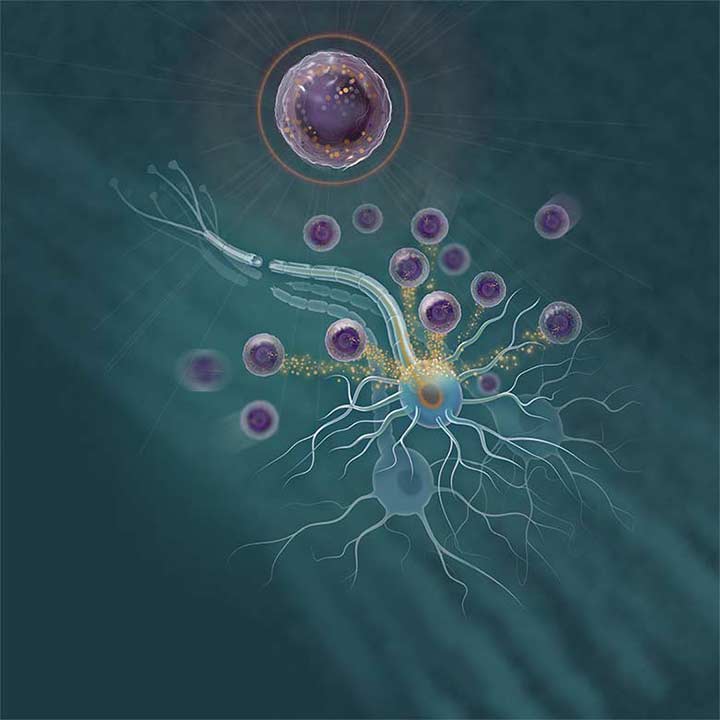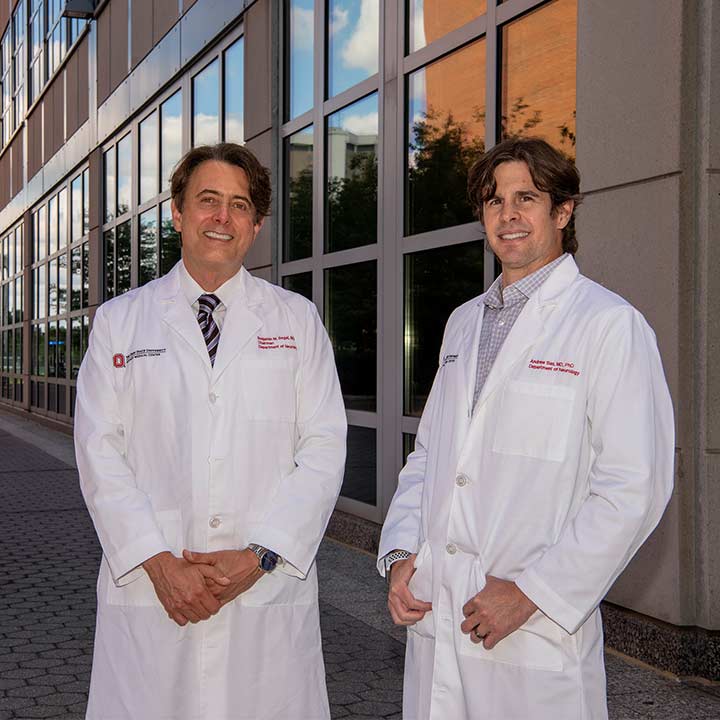
Finding neurology's 'holy grail'
 If there’s one thing people who suffer from neurological diseases and injuries are looking for, it’s hope.
If there’s one thing people who suffer from neurological diseases and injuries are looking for, it’s hope.
So when news breaks about a research development that holds great promise for regenerating damaged nerve fibers in the central nervous system — something that’s never been done in humans before — the emails and calls start flooding in.
Andrew Sas, MD, PhD (external link), can attest to that.
“These family members are very engaged in the scientific community,” says Dr. Sas, an assistant professor and physician-scientist in the Department of Neurology (external link) at The Ohio State University College of Medicine. “A lot of them are searching for better treatment than what they currently have. They’re always looking for an opportunity to be part of new clinical trials and therapies, and I don’t blame them.”
In late 2020, the emails started arriving after Ohio State announced that researchers here and at the University of Michigan — including Dr. Sas and Benjamin Segal, MD (external link), professor and chair of the Department of Neurology at the Ohio State College of Medicine and co-director of the Ohio State Wexner Medical Center’s Neurological Institute (external link) — had discovered in a mouse model a new type of immune cell that not only rescues damaged nerve cells from death, but partially reverses nerve fiber damage. Led by Dr. Segal, the research team also identified a human immune cell line with similar characteristics that promotes nervous system repair.
To Dr. Segal, one of the world’s foremost experts in multiple sclerosis and neuroimmunology, it was an astonishing breakthrough — one he’s been chasing his entire career.
“This is a pursuit of neurologists and neuroscience researchers globally,” he told a Chicago television station. “My whole career, this has been the holy grail.”
This “holy grail” is a unique cell among granulocytes, which are a type of white blood cell. Neutrophils, the most common granulocytes, normally help the body fight off infection. The unique cell type resembles an immature neutrophil but is distinctive in possessing neuroprotective and neuroregenerative properties. Researchers demonstrated the therapeutic potency of the immature neutrophils subset by injecting them into mice with crushed optic nerves or lacerated nerve fibers in the spinal cord. Mice injected with the new neutrophil subset grew new nerve fibers.
Since publishing their findings in the journal Nature Immunology, the researchers have moved from mouse models into human cell work with “promising” early results, Dr. Sas says. “We’re doing the things everyone asked us about nine months ago,” when news broke of the lab’s discovery and patient queries started pouring in. “It looks like some of the things we’re seeing in the mouse model are holding up with early human immune cell studies.”
Dr. Segal sees a future where patients with diseases as diverse as multiple sclerosis, Alzheimer’s, ALS and Parkinson’s, as well as patients with brain and spinal cord trauma, finally see some of the hope that has so far been elusive.
“There’s a wealth of data that’s been generated that’s really enhanced our understanding of neurological diseases and is leading the way to better testing and treatment,” Dr. Segal says. “All of this information is just on the verge of being translated to the bedside. I think the next several years–the next decade and beyond–is just going to explode with innovations at Ohio State.”
This discovery was a major step for a department that Dr. Segal has transformed since joining Ohio State in 2019. Colleagues say he’s built considerable depth into nearly every area within the Department of Neurology while also forging multidisciplinary clinics that span departments and elevating research across the organization.
“He has an interest in education, in our clinical mission and in our research, and he really works tirelessly in all three areas,” says Miriam Freimer, MD, professor of Neurology and the director of Division of Neuromuscular Disorders. “I think the next five years are going to be exciting for Ohio State Neurology.”
Of particular excitement is Dr. Segal’s focus on finding new ways to infuse research throughout his department and strengthen a robust state-of-the-art biorepository and brain bank through a practice of regularly collecting patient samples for investigators to study. He’s also fostering innovative connections between clinicians and scientists through a consultative committee for scientists who want to investigate whether findings in animal models translate in human diseases — creating a portal for clinicians to better translate research into bedside treatments.
“I’m trying to get the whole department and its divisions involved in particular research questions and projects,” Dr. Segal says.
An example: He’s introduced a research aspect into the neurology residency program and paired each resident with a research mentor. Residents have three years to take on a research project — anything from a simple case series to something more complex.
One resident approached Dr. Segal to say he was interested in measuring a particular molecule in the blood of patients with Guillain-Barré syndrome. Dr. Segal challenged him to pursue that interest and take it even further, using blood and spinal fluid samples to analyze inflammation in a way that’s never been done. The project is now a team effort that includes multiple residents and
Neuromuscular faculty members and has established a seamless system of obtaining patient consent to collect and study samples. The resident was awarded an internationally competitive grant to fund this project.
For this and future research, Dr. Segal says, “The whole machinery is now in place.”
In Dr. Segal’s lab, Dr. Sas and others are continuing their work exploring the regenerative power of immune cells—a different avenue than stem cells, which many have tried unsuccessfully to use for the same purpose. Dr. Sas believes the field is heading toward more human research, and Dr. Segal’s lab in particular will be one to watch. “The work that we’re doing in the Segal lab,” Dr. Sas says, “is cutting edge—and has the chance to produce completely novel therapies.”